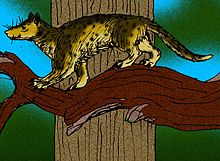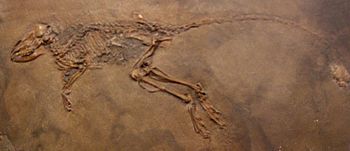- Miacids
-
Miacids
Temporal range: Late Paleocene - Early Eocene 65–33 Ma
Scientific classification Kingdom: Animalia Phylum: Chordata Class: Mammalia (unranked): Carnivoramorpha Superfamily: Miacoidea Family: Miacidae
Cope, 1880Genera See text.
Miacids (Miacidae) were primitive carnivores which lived during the late Paleocene and Eocene epochs about 62—33 million years ago. Miacids existed for approximately 29 million years.
Miacids are thought to have evolved into today's modern carnivorous mammals of the order Carnivora. They were small carnivores, superficially marten-like or civet-like with long, little bodies and long tails. Some species were arboreal while others lived on the ground.
They probably fed on invertebrates, lizards, birds, and smaller mammals like shrews and opossums. Their teeth and skulls show that the miacids were less developed than modern carnivorans. They had carnivoran-type carnassials but lacked fully ossified auditory bullae (rounded protrusions).
Classification
Miacidae as traditionally conceived is not a monophyletic group; it is a paraphyletic array of stem taxa. Traditionally, Miacidae and Viverravidae had been classified in a superfamily, Miacoidea. Today, Carnivora and Miacoidea are grouped together in the crown-clade Carnivoramorpha, and the Miacoidea are regarded as basal carnivoramorphs. Some species of the genus Miacis are closely related to the order Carnivora, but only the species Miacis cognitus is a true carnivoran, as it is classified in the Caniformia.
The transition from miacids to Carnivora was a general trend in the middle and late Eocene with taxa from both North America and Eurasia involved. The divergence of carnivorans from miacids is now inferred to have occurred in the middle-Eocene (ca. 42 million years ago). Traditionally the Viverravidae (viverravids) had been thought to be the earliest carnivorans with fossil records first appearing in the Paleocene of North America about 60 million years ago, but recent cranial morphology evidence now places them outside the order Carnivora.[1]
Taxonomy
- Family Miacidae†
-
- Genus Eosictis
- Genus Messelogale[2]
- Genus Miacis
- Genus Miocyon
- Genus Oodectes
- Genus Palaearctonyx
- Genus Paramiacis
- Genus Paroodectes
- Genus Procynodictis[3]
- Genus Prodaphaenus
- Genus Quercygale[4]
- Genus Tapocyon
- Genus Uintacyon
- Genus Vassacyon
- Genus Vulpavus
- Genus Xinyuictis
- Genus Ziphacodon
References
- ^ Polly, David, Gina D. Wesley-Hunt, Ronald E. Heinrich, Graham Davis and Peter Houde (2006). "Earliest Known Carnivoran Auditory Bulla and Support for a Recent Origin of Crown-Clade Carnivora (Eutheria, Mammalia)". Palaeontology 49 (5): 1019–1027. doi:10.1111/j.1475-4983.2006.00586.x. http://mypage.iu.edu/~pdpolly/Papers/Polly%20et%20al,%202006,%20Viverravus.pdf.
- ^ Morlo, M.; Schaal, S.; Mayr, G.; Seiffert, C. (2004). "An annotated taxonomic list of the Middle Eocene (MP11) Vertebrata of Messel". Courier Forschungsinstitut Senckenberg 252: 95–108. http://www.senckenberg.de/files/content/forschung/abteilung/terrzool/ornithologie/morlo_et_al.pdf. Retrieved 2008-05-18.
- ^ Wesley, G.D.; Flynn, J.J. (2003). "A revision Of Tapocyon (Carnivoramorpha), including analysis of the first cranial specimens and identification of a new species". Journal of Paleontology 77 (4): 769–783. doi:10.1666/0022-3360(2003)077<0769:AROTCI>2.0.CO;2.
- ^ Wesley-Hunt, G.D.; Werdelin, L. (2005). "Basicranial morphology and phylogenetic position of the upper Eocene carnivoramorphan Quercygale". Acta Palaeontologica Polonica 50 (4): 837–846. http://psjc.icm.edu.pl/psjc/cgi-bin/getdoc.cgi?AAAA015045. Retrieved 2008-05-18.
Categories:
Wikimedia Foundation. 2010.

